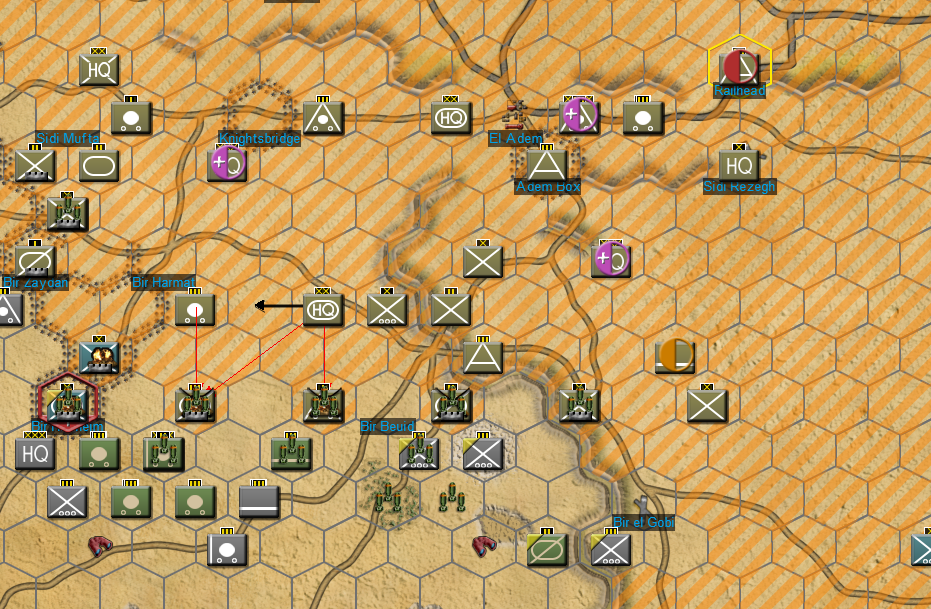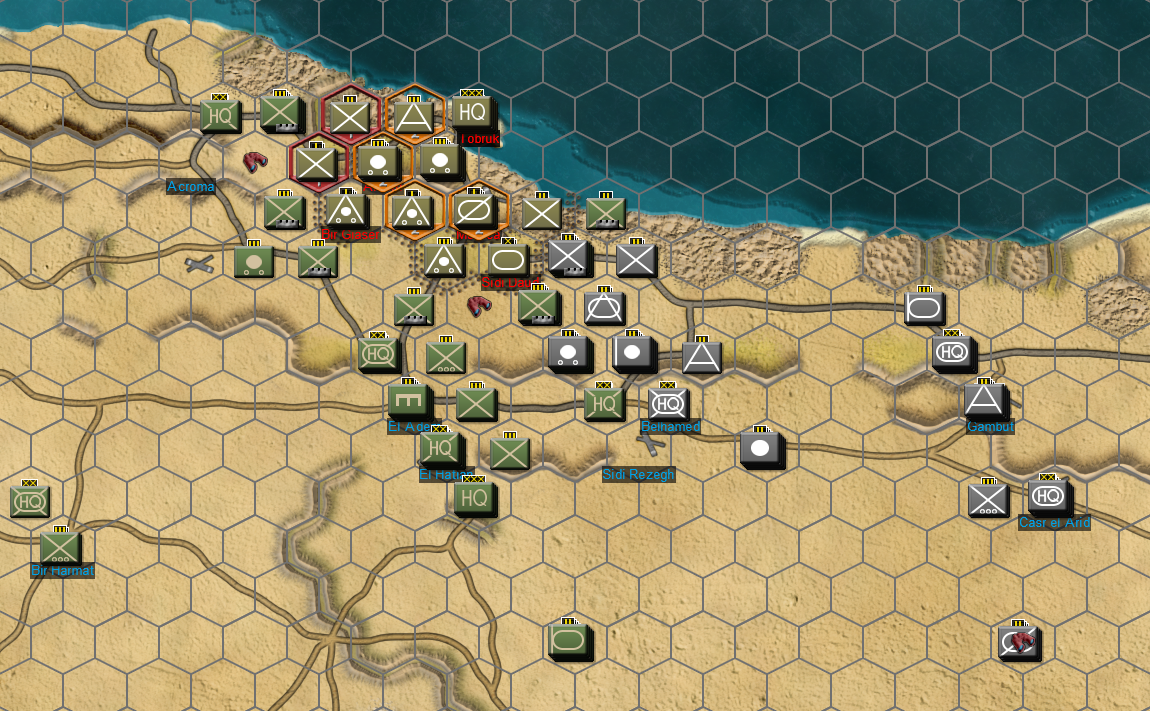General Gameplay Additions and Changes:
- Frontier Wire map, an extended version of Tobruk stretching to Sidi Barrani in the east and beyond Fort Maddalena in the south. A variant of this map will form the basis of the upcoming Operation Crusader scenario.
- Out of supply cohesion loss increased for units experienced training level and above.
- Minor additions to Axis and Allied Crusader OBs.
- Updated Gazala Line scenario to better represent the fortress at Tobruk during the battle.
- Fixed unintended coastal minefield bypass north of Acroma in the Gazala Line scenario.
- Added co-op air control to Gazala Line scenario.
Supply Interface Improvements:

- Yellow tags now appear on units below 100% supply, orange tags for units completely out of supply. These tags display at all times. No more being surprised to learn your tanks are out of supply.
- Supply overlay now differentiates between static supply sources (red), mobile depots (orange), and supply extenders (purple).
Air Superiority Changes:
Update 1.0.3.3 completes the air overhaul initiated in the last update, with extensive changes to the air superiority system. Maneuverability is better incorporated into the combat stat of aircraft, air superiority mission numbers per squadron have been overhauled, and maintenance rates have been comprehensively re-evaluated.Air Superiority and Air Weapon stat Revisions:
Playtesting the historical Gazala Line and upcoming Operation Crusader scenarios revealed our existing air system undervalued highly maneuverable, but relatively short-ranged fighters such as Spitfires, BF-109s, and MC.202s. The revisions detailed below better incorporate maneuverability into the air combat stat and rework the air superiority mission number calculation which previously excessively advantaged intermediate range fighters such as P-40s against their shorter ranged counterparts.The list below shows the highlights of the changes for each nation.
Details
United Kingdom:
Multirole- Typhoon Ib air combat increased from 57.7 to 70.1
- Tempest V air combat increased from 61.5 to 79.7
- Tempest V air superiority missions increased from 3 to 3.5 per squadron.
Fighters
- Gladiator II air combat increased from 36 to 44.9
- Hurricane IIa air combat increased from 42.8 to 52.1
- Spitfire IIa air combat increased from 48 to 59.7
- Spitfire Vb air combat increased from 53.7 to 66
- Spitfire Vb air superiority missions increased from 2 to 3 per squadron.
- Spitfire IXe air combat increased from 60 to 73.6
- Spitfire IXe air superiority missions increased from 2 to 3 per squadron.
- Spitfire XIV air combat increased from 62.3 to 76.5
- Spitfire XIV air superiority missions increased from 2 to 3 per squadron.
- Spitfire XXI air combat increased from 68.5 to 83.6
- Spitfire XXI air superiority missions increased from 3 to 3.5 per squadron.
Bomber/Strike
- Blenheim IV air combat increased from 29.8 to 36.7
- Mosquito FB.VI air combat increased from 56 to 65.
United States:
Multirole/Fighter- P-26 air combat increased from 28.9 to 35.9
- P-36 air combat increased from 35.3 to 44.7
- P-40B air combat increased from 46.4 to 53.3
- P-40F air combat increased from 48.1 to 58.9
- P-40N-5 air combat increased from 50.3 to 61.7
- P-38F air combat increased from 50.6 to 61.8
- P-47D air combat increased from 56.1 to 68.5.
- P-51B air combat increased from 55.2 to 68.2
- P-51D air combat increased from 58.1 to 71.4
Bomber/Strike
- B-18A Bolo air combat increased from 23.8 to 29.5
- A-20B Havoc air combat increased from 42.9 to 50.3
- B-25H Mitchel air combat increased from 34 to 37.9
Germany:
Multirole- BF-110 C-4 air combat increased from 42.8 to 52.4
- FW-190 F-8 air combat increased from 52.2 to 63.7
/Fighter
- BF-109 E-3 air combat increased from 45.9 to 56.5
- BF-109 E-4 air combat increased from 48.3 to 59.5
- BF-109 F-4 air combat increased from 51.3 to 62.3
- BF-109 F-4 air superiority missions increased from 2 to 3 per squadron.
- BF-109 G-6 air combat increased from 58 to 70.5
- BF-109 F-4 air superiority missions increased from 2 to 3 per squadron.
- FW-190 A-4 air combat increased from 59 to 71.8
- FW-190 A-4 air superiority missions decreased from 4 to 3.5 per squadron.
- FW-190 A-8 air combat increased from 62.8 to 76
- FW-190 D-9 air combat increased from 68.7 to 83.3
- ME-262 A-1a air combat increased from 104.5 to 125.3
Bomber/Strike
- JU-87 B-1 air combat increased from 27.1 to 33.6
- JU-88 A-4 air combat increased from 30.6 to 37.6
- JU-188 E-1 air combat increased from 32.9 to 41.5
Italy:
Multirole:- RE.2002 air combat increased from 41.2 to 51.1
- RE.2005 air combat increased from 56.8 to 69.1
Fighter:
- CR.42 air combat increased from 34.6 to 43.1
- CR.42 air superiority missions increased from 1 to 1.5 per squadron.
- G.50 air combat increased from 37.2 to 46.2
- MC.200 air combat increased from 38.1 to 48.2
- MC.202 air combat increased from 42.5 to 52.8
- MC.202 air superiority missions increased from 2 to 3 per squadron.
- MC.205V air combat increased from 57.4 to 70.3
- MC.205V air superiority missions increased from 3 to 3.5 per squadron.
Bomber:
- CANT Z.1007 bis air combat increased from 33.3 to 40.2
- BR.20M air combat increased from 31.4 to 38.2
- Ca.311 air combat increased from 22.3 to 27.5
France:
Fighter:- D.510 air combat increased from 34.7 to to 42.7
- MB.151 air combat increased from 35.3 to 43.7
- MS.406 C1 air combat increased from 39.8 to 49.1
- Hawk 75A3 air combat increased from 42.46 to 52.5
- D.520 C1 air combat increased from 44 to 54.2
- Potez 631 air combat increased from 41.2 to 50.3
Bomber:
- Potez 633 B2 air combat increased from 32.1 to 39.9
- MB. 210 air combat increased from 20 to 24.8
- LeO 451 air combat increased from 38.4 to 47.4
Soviet Union:
Fighter:- I-15 air combat increased from 32.5 to 40.4
- I-16 Type 24 air combat increased from 40.1 to 46.1
- YaK-1 air combat increased from 46.6 to 57.9
- Yak-7 air combat increased from 51.7 to 63.6
- Yak-9 air combat increased from 50.1 to 61.9
- La-5Fn (early) air combat increased from 50 to 60.6
- La-5Fn air superiority missions increased from 2 to 3 per squadron.
- La-7 air combat increased from 56 to 68.4
- La-7 air superiority missions increased from 2 to 3 per squadron.
Strike/Bomber:
- IL-2M3 air combat increased from 41.8 to 50.5
- PE-3 bis air combat increased from 45.2 to 55.3
- SB-2M air combat increased from 33.1 to 41.1
- TU-2S air combat increased from 46 to 59.8
Air Maintenance Revisions:
Maintenance rates now closely correlate with the number of engines an aircraft has, the more engines the slower the maintenance order recovers cohesion. Maintenance rates are further modified by national bonuses, and case-specific modifiers on a per-aircraft basis. Single-engine aircraft average between 17-25% cohesion recovery per turn in maintenance, twin/triple-engine aircraft average around 10-15%. In general, US and UK airframes enjoy highest cohesion recovery from maintenance, while French aircraft typically round out the bottom.These maintenance revisions add a further layer of strategy to air combat, because powerful bombers, versatile twin-engine multirole, and exotic aircraft such as ME-262s, suffer from slow maintenance rates. If you keep all of your aircraft active constantly, and keep nothing in reserve, you will create an aircraft readiness crisis that you can’t quickly recover from.
Bug Fixes:
- Fixed a bug that occasionally caused AI units to skirmish each other in friendly fire incidents.
- Fixed a bug that caused the AI to overestimate its casualties and surrender early in historical scenarios.
- Fixed a bug that prevented pre-game line of sight makers from displaying properly in the LOS overlay.
- Fixed a bug that caused objective highlights to duplicate, making objective value difficult to read on hexes with multiple facilities (forts, airfields, towns, etc.).
Beyond 1.0.3.3:
Operation Crusader is in production for our next update, and after that we’re on to Operation Husky. There are also some outstanding AI issues brought to our attention by community members in the Gazala Line scenario, relating to the AI exposing its corps HQs and abandoning minefield-based defense positions. We’ll look into these either individually as part of the upcoming updates, or as part of a specifically AI-themed update after OP Husky release. In the meantime, here’s a peak at the formidable fortress at Tobruk besieged in the upcoming Operation Crusader scenario.

Changed files in this update